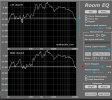I"m a beta tester at Mathaudio discussed with Sergey one of the technical contact persons my full range correction. He stated their nothing wrong regarding a full correction better he encourage it as a starting point. From there on move the slider up till maximum transparency specific for You is reached. So i did an because of the Scientific statement don't correctl not above 4 or 500 hz I let many people hear specific in my room the correction bypass sound an other target curves basicly all agree the full range correction is by far the best nothing to do with your mind pure observation.Someone more clued up might set me right, but as I now understand it there’s a solid scientific reason not correct above 500Hz or so.
From what I’ve read in the posts quoting Toole, linked above, the sound heard at higher frequencies (above 500Hz or so) is a mixture of direct and reflected sound, but your brain filters out reflections as just reflections. However, a measurement mic can’t do that.
If you have speakers that measure flat under anechoic conditions, then measure those speakers in your room, your measurement mic will combine the direct and reflected sounds to show a response that is anything but flat.
It’s fine to correct lower frequencies as you’re removing the gain added by the room, which your brain can’t discern as anything else.
But if you correct the deviations from flat at higher frequencies, you’re adding filters to a response that your brain has already filtered, so you’re actually adding deviations from flat to the signal from your nice flat speakers.
I guess that Mathaudio has a specific way of correcting. Because my Vandersteen speakers are by build phase coherent speakers I did ask how Mathaudio handels phase Behaviour Mathaudio did not want to eleborate in depth about how they do it (Competively quite understandable) other than if i have phase coherent speakers Mathaudio has to correct less.
See graph from Mathaudio as a starting point. Way down (in contrast to only correct till 4 or 500hz) Full correction an work you way up if necccecery. https://mathaudio.com/room-eq.htm
Last edited:

 ) an than use the bypass button see what happens an go from there on.
) an than use the bypass button see what happens an go from there on.